(完整)高中英语直接引语和间接引语讲解
- 格式:doc
- 大小:88.53 KB
- 文档页数:6
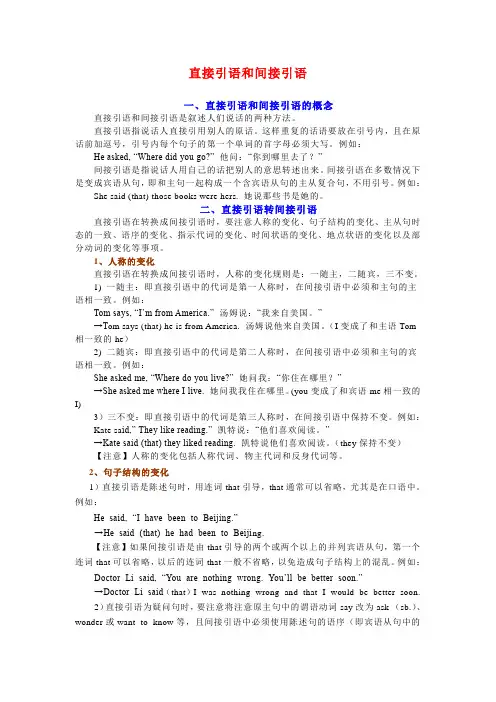
直接引语和间接引语一、直接引语和间接引语的概念直接引语和间接引语是叙述人们说话的两种方法。
直接引语指说话人直接引用别人的原话。
这样重复的话语要放在引号内,且在原话前加逗号,引号内每个句子的第一个单词的首字母必须大写。
例如:He asked, “Where did you go?” 他问:“你到哪里去了?”间接引语是指说话人用自己的话把别人的意思转述出来。
间接引语在多数情况下是变成宾语从句,即和主句一起构成一个含宾语从句的主从复合句,不用引号。
例如:She said (that) those books were hers. 她说那些书是她的。
二、直接引语转间接引语直接引语在转换成间接引语时,要注意人称的变化、句子结构的变化、主从句时态的一致、语序的变化、指示代词的变化、时间状语的变化、地点状语的变化以及部分动词的变化等事项。
1、人称的变化直接引语在转换成间接引语时,人称的变化规则是:一随主,二随宾,三不变。
1) 一随主:即直接引语中的代词是第一人称时,在间接引语中必须和主句的主语相一致。
例如:Tom says, “I’m from America.” 汤姆说:“我来自美国。
”→T om says (that) he is from America. 汤姆说他来自美国。
(I变成了和主语Tom 相一致的he)2) 二随宾:即直接引语中的代词是第二人称时,在间接引语中必须和主句的宾语相一致。
例如:She asked me, “Where do you live?” 她问我:“你住在哪里?”→She asked me where I live. 她问我我住在哪里。
(you变成了和宾语me相一致的I)3)三不变:即直接引语中的代词是第三人称时,在间接引语中保持不变。
例如:Kate sa id,” They like reading.” 凯特说:“他们喜欢阅读。
”→Kate said (that) they liked reading. 凯特说他们喜欢阅读。
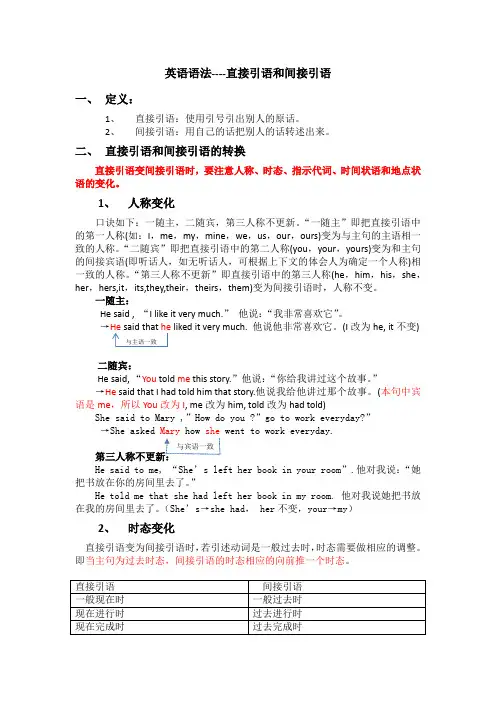
英语语法----直接引语和间接引语一、 定义:1、 直接引语:使用引号引出别人的原话。
2、间接引语:用自己的话把别人的话转述出来。
二、 直接引语和间接引语的转换直接引语变间接引语时,要注意人称、时态、指示代词、时间状语和地点状语的变化。
1、 人称变化口诀如下:一随主,二随宾,第三人称不更新。
“一随主”即把直接引语中的第一人称(如:I ,me ,my ,mine ,we ,us ,our ,ours)变为与主句的主语相一致的人称。
“二随宾”即把直接引语中的第二人称(you ,your ,yours)变为和主句的间接宾语(即听话人,如无听话人,可根据上下文的体会人为确定一个人称)相一致的人称。
“第三人称不更新”即直接引语中的第三人称(he ,him ,his ,she ,her ,hers,it ,its,they,their ,theirs ,them)变为间接引语时,人称不变。
一随主:He said , “I like it very much.” 他说:“我非常喜欢它”。
→liked it very much. 他说他非常喜欢它。
(I 改为he, it 不变)二随宾:He said, “You told me this story.”他说:“你给我讲过这个故事。
”→He said that I had told him that story.他说我给他讲过那个故事。
(本句中宾语是me ,所以You 改为I , me 改为him, told 改为had told)She said to Mary ,”How do you ?”go to work everyday?” →She asked Mary how she went to work everyday. 第三人称不更新:He said to me, “She’s left her book in your room ”.他对我说:“她把书放在你的房间里去了。

语法干货直接引语和间接引语最全讲解直接引语和间接引语的概述在直接引用别人的原话时,被引用的句子称为直接引语。
在用直接引语时,引语前后都要加引号。
引导引语的动词称为引用动词,如:say, ask, answer, reply等。
引用动词多数放在后面,有时放在前面,间或插在引语中间。
在把引用动词放在后面时,有时主语和动词位置可以颠倒(特别是主语较长时)。
例如:“Who is it?” Ann shouted.“I never eat meat,” she explained.“Sit up,” he commanded, “and hold out your hands.”当用自己的话转述别人的话时,被转述的部分称为间接引语。
这时被引语部分常常是引用动词的宾语。
在多数情况下,引语都由连词that引导,但在say, tell等词后可以省略。
例如:He said (that) he had lost the bag.Tell her I am out.把直接引语变成间接引语时,要改变的内容1. 要根据意思改变人称。
2. 要根据时态呼应的原则把时态加以调整。
3. 指示代词、时间状语、地点状语和动词也需要作必要的变动。
各种句式变间接引语时要发生的变化1. 陈述句直接引语如果是陈述句,变为间接引语时,用连词that引导 (that 可省略)。
例如:Tony said to me, “ I will leave this book in your desk.”→Tony told me (that) he would leave that book in my desk.如果直接引语是表示建议、要求、推测、判断的陈述句,变为间接引语时,可以变为动词不定式、V-ing形式或含虚拟语气的宾语从句。
例如:Jane said to Tony, “You’d better ask your friends for some advice.”→Jane advised Tony to ask his friends for some advice.→Jane suggested Tony asking his friends for some advic e.→Jane advised/suggested that T ony (should) ask his friends for some advice.2. 一般疑问句、选择疑问句和反意疑问句直接引语是一般疑问句,变为间接引语时,要用连词whether或if引导,同时把原来的疑问句语序变为陈述句语序。
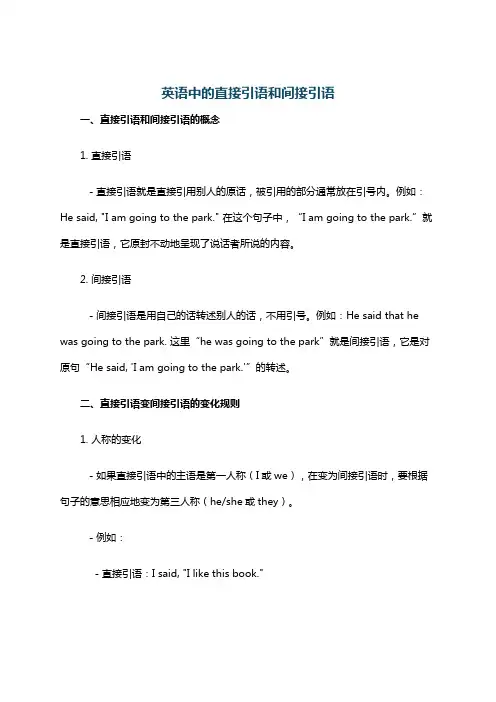
英语中的直接引语和间接引语一、直接引语和间接引语的概念1. 直接引语- 直接引语就是直接引用别人的原话,被引用的部分通常放在引号内。
例如:He said, "I am going to the park." 在这个句子中,“I am going to the park.”就是直接引语,它原封不动地呈现了说话者所说的内容。
2. 间接引语- 间接引语是用自己的话转述别人的话,不用引号。
例如:He said that he was going to the park. 这里“he was going to the park”就是间接引语,它是对原句“He said, 'I am going to the park.'”的转述。
二、直接引语变间接引语的变化规则1. 人称的变化- 如果直接引语中的主语是第一人称(I或we),在变为间接引语时,要根据句子的意思相应地变为第三人称(he/she或they)。
- 例如:- 直接引语:I said, "I like this book."- 间接引语:I said that I liked this book.(这里因为主语都是I,人称不变,但如果是He said, "I like this book." 变为间接引语就是He said that he liked this book.)- 如果直接引语中的第二人称(you),在变为间接引语时,要根据转述者和听话者的关系变为第一人称(I/we)或第三人称(he/she/they)。
- 例如:- 直接引语:He said to me, "You are a good student."- 间接引语:He told me that I was a good student.- 直接引语:He said to her, "You should study hard."- 间接引语:He told her that she should study hard.2. 时态的变化- 一般现在时变为一般过去时。
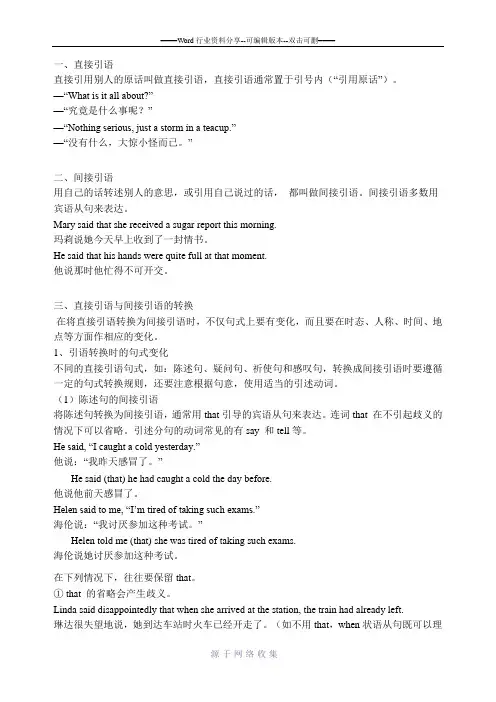
一、直接引语直接引用别人的原话叫做直接引语,直接引语通常置于引号内(“引用原话”)。
—“What is it all about?”—“究竟是什么事呢?”—“Nothing serious, just a storm in a teacup.”—“没有什么,大惊小怪而已。
”二、间接引语用自己的话转述别人的意思,或引用自己说过的话,都叫做间接引语。
间接引语多数用宾语从句来表达。
Mary said that she received a sugar report this morning.玛莉说她今天早上收到了一封情书。
He said that his hands were quite full at that moment.他说那时他忙得不可开交。
三、直接引语与间接引语的转换在将直接引语转换为间接引语时,不仅句式上要有变化,而且要在时态、人称、时间、地点等方面作相应的变化。
1、引语转换时的句式变化不同的直接引语句式,如:陈述句、疑问句、祈使句和感叹句,转换成间接引语时要遵循一定的句式转换规则,还要注意根据句意,使用适当的引述动词。
(1)陈述句的间接引语将陈述句转换为间接引语,通常用that引导的宾语从句来表达。
连词that 在不引起歧义的情况下可以省略。
引述分句的动词常见的有say 和tell等。
He said, “I caught a cold yesterday.”他说:“我昨天感冒了。
”He said (that) he had caught a cold the day before.他说他前天感冒了。
Helen said to me, “I’m tired of taking such exams.”海伦说:“我讨厌参加这种考试。
”Helen told me (that) she was tired of taking such exams.海伦说她讨厌参加这种考试。
在下列情况下,往往要保留that。
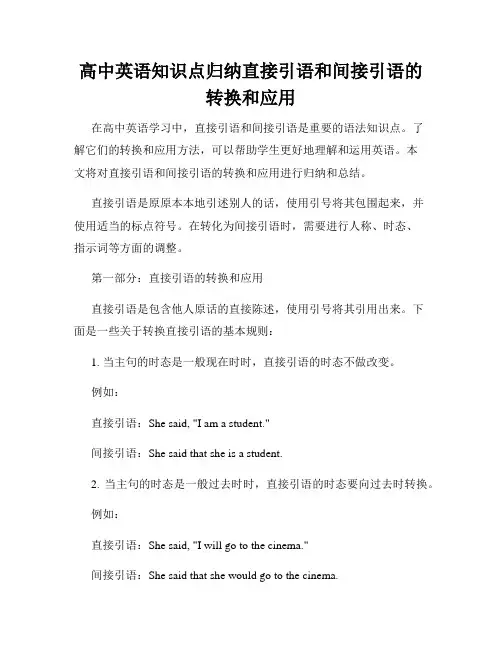
高中英语知识点归纳直接引语和间接引语的转换和应用在高中英语学习中,直接引语和间接引语是重要的语法知识点。
了解它们的转换和应用方法,可以帮助学生更好地理解和运用英语。
本文将对直接引语和间接引语的转换和应用进行归纳和总结。
直接引语是原原本本地引述别人的话,使用引号将其包围起来,并使用适当的标点符号。
在转化为间接引语时,需要进行人称、时态、指示词等方面的调整。
第一部分:直接引语的转换和应用直接引语是包含他人原话的直接陈述,使用引号将其引用出来。
下面是一些关于转换直接引语的基本规则:1. 当主句的时态是一般现在时时,直接引语的时态不做改变。
例如:直接引语:She said, "I am a student."间接引语:She said that she is a student.2. 当主句的时态是一般过去时时,直接引语的时态要向过去时转换。
例如:直接引语:She said, "I will go to the cinema."间接引语:She said that she would go to the cinema.3. 当直接引语是被引述者的陈述句时,可以使用that来引导间接引语。
例如:直接引语:He said, "I am happy."间接引语:He said that he was happy.第二部分:间接引语的转换和应用间接引语是将直接引语转换为自己的话,不使用引号,而是通过动词引导和适当的调整来传达别人的话。
以下是一些关于应用间接引语的基本规则:1. 当直接引语中有一些特定的指示词(如now、here、this、these),在转换成间接引语时要进行相应的改变。
例如:直接引语:She said, "I am going now."间接引语:She said that she was going then.2. 当引述者自己有一些表示过去的指示词时,要根据语境进行适当调整。
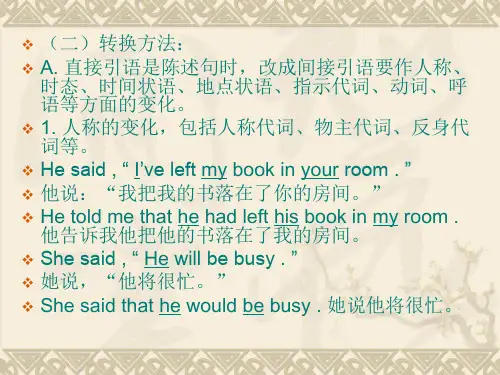
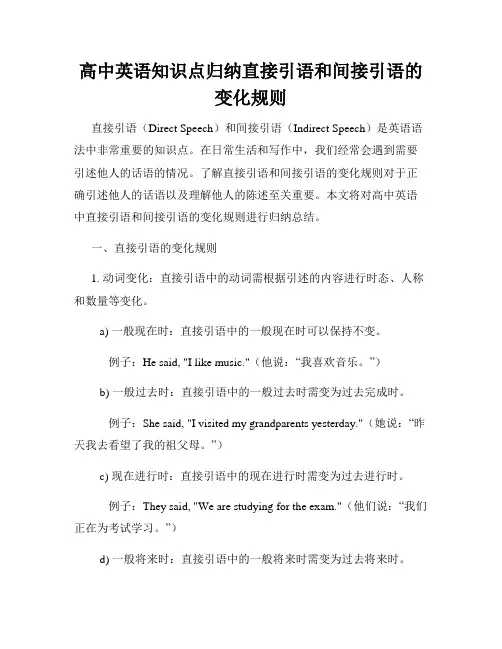
高中英语知识点归纳直接引语和间接引语的变化规则直接引语(Direct Speech)和间接引语(Indirect Speech)是英语语法中非常重要的知识点。
在日常生活和写作中,我们经常会遇到需要引述他人的话语的情况。
了解直接引语和间接引语的变化规则对于正确引述他人的话语以及理解他人的陈述至关重要。
本文将对高中英语中直接引语和间接引语的变化规则进行归纳总结。
一、直接引语的变化规则1. 动词变化:直接引语中的动词需根据引述的内容进行时态、人称和数量等变化。
a) 一般现在时:直接引语中的一般现在时可以保持不变。
例子:He said, "I like music."(他说:“我喜欢音乐。
”)b) 一般过去时:直接引语中的一般过去时需变为过去完成时。
例子:She said, "I visited my grandparents yesterday."(她说:“昨天我去看望了我的祖父母。
”)c) 现在进行时:直接引语中的现在进行时需变为过去进行时。
例子:They said, "We are studying for the exam."(他们说:“我们正在为考试学习。
”)d) 一般将来时:直接引语中的一般将来时需变为过去将来时。
例子:He said, "I will go to the cinema tomorrow."(他说:“明天我将去电影院。
”)2. 代词变化:直接引语中的人称代词(例如I、you、he、she、they 等)需按照引述者的身份进行变化。
例子:He said, "I am going to the park."(他说:“我要去公园。
”)3. 时间和地点变化:直接引语中的时间和地点词语需根据实际情境进行变化。
例子:She said, "I will meet you at the library tomorrow."(她说:“明天我会在图书馆见你。
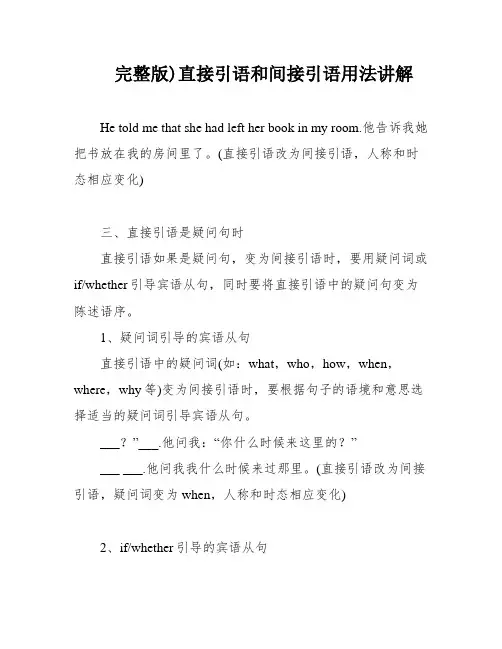
完整版)直接引语和间接引语用法讲解He told me that she had left her book in my room.他告诉我她把书放在我的房间里了。
(直接引语改为间接引语,人称和时态相应变化)三、直接引语是疑问句时直接引语如果是疑问句,变为间接引语时,要用疑问词或if/whether引导宾语从句,同时要将直接引语中的疑问句变为陈述语序。
1、疑问词引导的宾语从句直接引语中的疑问词(如:what,who,how,when,where,why等)变为间接引语时,要根据句子的语境和意思选择适当的疑问词引导宾语从句。
___?”___.他问我:“你什么时候来这里的?”___ ___.他问我我什么时候来过那里。
(直接引语改为间接引语,疑问词变为when,人称和时态相应变化)2、if/whether引导的宾语从句直接引语中如果是以是否开头的疑问句,变为间接引语时,要用if/whether引导宾语从句。
___?”Shesaid.她说:“你认识他吗?”___/___.她问我是否认识他。
(直接引语改为间接引语,疑问句变为陈述语序)四、直接引语是祈使句时直接引语如果是祈使句,变为间接引语时,要用动词不定式(to+动词原形)来表达。
___!”___.男孩对他说:“把书打开!”___告诉他打开书。
(直接引语改为间接引语,用动词不定式表达)五、直接引语是感叹句时直接引语如果是感叹句,变为间接引语时,要用连词how 或what来引导宾语从句。
___!”Hesaid.他说:“多么漂亮的女孩!”___.他说那个女孩有多漂亮。
(直接引语改为间接引语,用how引导宾语从句)___ me that she had left her book in my room。
When changing direct ___ indirect speech。
the tense of the verb in the ___ of the verb in the main clause。
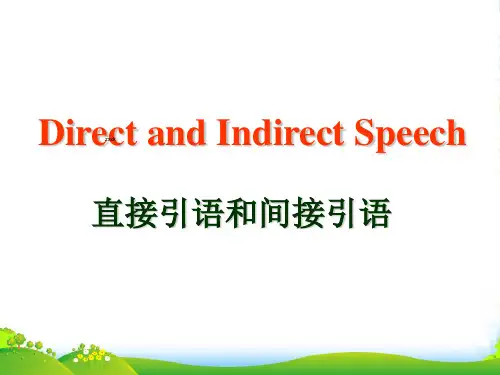
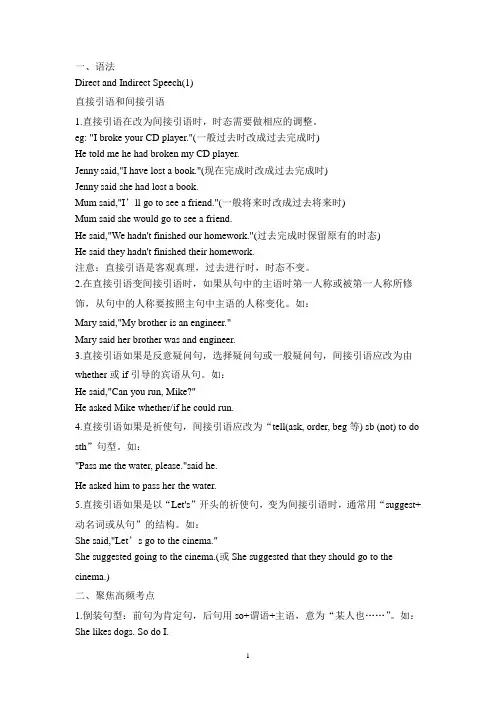
一、语法Direct and Indirect Speech(1)直接引语和间接引语1.直接引语在改为间接引语时,时态需要做相应的调整。
eg: "I broke your CD player."(一般过去时改成过去完成时)He told me he had broken my CD player.Jenny said,"I have lost a book."(现在完成时改成过去完成时)Jenny said she had lost a book.Mum said,"I’ll go to see a friend."(一般将来时改成过去将来时)Mum said she would go to see a friend.He said,"We hadn't finished our homework."(过去完成时保留原有的时态)He said they hadn't finished their homework.注意:直接引语是客观真理,过去进行时,时态不变。
2.在直接引语变间接引语时,如果从句中的主语时第一人称或被第一人称所修饰,从句中的人称要按照主句中主语的人称变化。
如:Mary said,"My brother is an engineer."Mary said her brother was and engineer.3.直接引语如果是反意疑问句,选择疑问句或一般疑问句,间接引语应改为由whether或if引导的宾语从句。
如:He said,"Can you run, Mike?"He asked Mike whether/if he could run.4.直接引语如果是祈使句,间接引语应改为“tell(ask, order, beg等) sb (not) to do sth”句型。
高中英语知识点归纳直接引语和间接引语的特殊情况直接引语和间接引语是英语语法中的重要内容,它们在交流和书面表达中起到了至关重要的作用。
了解直接引语和间接引语的特殊情况,可以帮助我们更准确地理解和运用英语。
本文将对高中英语知识点归纳直接引语和间接引语的特殊情况进行详细介绍。
一、直接引语和间接引语的概念直接引语(Direct Speech)指直接引用别人的原话,用来表达他人说过的内容。
间接引语(Indirect Speech)是将别人的原话转述为间接引语,以自己的话来表达他人说的内容。
二、直接引语和间接引语的一般规则一般情况下,直接引语和间接引语之间的变化包括以下几个方面:1.人称的变化:当宾语是第一人称时,要改变人称。
2.时态的变化:通常将直接引语中的时态转换成比较接近的时态。
3.引导词和标点的变化:引导词通常要加上适当的连词,标点也需要相应的变化。
下面将对直接引语和间接引语的特殊情况进行具体讲解。
三、直接引语和间接引语的特殊情况1.特殊疑问句的引述当直接引语是特殊疑问句时,间接引语要使用“asked”或者“wondered”等动词引导,同时要将疑问句改为陈述句。
例子:Direct Speech (直接引语): "Where are you going?" he asked.Indirect Speech (间接引语): He asked where I was going.2.陈述句的特殊情况当直接引语是陈述句且为真理、客观事实或总结性陈述时,间接引语不需要改变时态、人称和时间等。
例子:Direct Speech (直接引语): "Water boils at 100 degrees Celsius."Indirect Speech (间接引语): He said that water boils at 100 degrees Celsius.3.祈使句的引述当直接引语是祈使句时,间接引语中要使用“tell”或者“ask”等动词引导,同时要注意将时态、人称和标点做相应的调整。
直接引语和间接引语一、概念:直接引语指直接引用别人的话,故必须有引号;间接引语为转述别人的话,无引号。
e.g. He said, "I went to the Green Lake yesterday. ”(直接弓I语)He said that he had gone to the Green Lake the day before.(间接弓I语)二、步骤(如何把直接引语变为间接引语):连接词f人称T时态f状语f语序第一步:连接词1、直接引语为陈述句,用that.2、直接引语为一般疑问句,用whether或if(主句动词常为ask)3、直接引语为特殊疑问句,用特殊疑问词(what, when, how等)4、直接引语为祈使句,用tell/order/ask sb. (not) to do sth.e.g.(1)He said, I went to the Green Lake yesterday."(陈述句)He said that …(2)He asked, “ Di(you go to the Green Lake yesterday? ”He asked whether /if …(3)Don' make so much noise, children! she said.She told the childre n not to make so much no ise.第二步:人称的变化一般可以通过翻译来转化人称,也可以通过口诀“一随主,二随宾,第三人称不更新”来记忆。
e.g. He said, we l t to the Green Lake yesterday. ”He said that he …翻译出来为:(他说,“我昨天去翠湖了。
”),那么转换过来为:(他说他昨天去了翠湖。
)由此可见,翻译出来后人称很好转化。
第三步:时态的变化(弓I号内的内容向前推一个时态)e.g. He said, " I went to the Green Lake yesterday. ”(一般过去时) He said that he had gone ...(过去完成时)【注意】以下几种情况时态不变①直接引语是客观真理。
高中英语,直接引语和间接引语的用法直接引语和间接引语直接引语:直接引用原文:He said"I am a good boy"他说我是一个好男孩间接引语:间接引用原文:He said he was a good boy 他说他是一个好男孩直接引语变成间接引语第一种:He says"I am a happy today "------- He said he was a happy boy第二种:He asks me"Do you like apples?"-------- He asked me if I liked apples 第三种:He asks"What color is it ?"------He asked what color it was。
第四种:He says "one and one is two"-------He said that one and one is two直接引语变成间接引语时,时间状语,地点状语变化的原则This---that,these---those,now---then,today---that day,this evening ---that evening,Yesterday---the day before the previous day,yesterday morning-----the morning before,Last night---the night before,two days ago------two days before,next week----the next week,the following day,tomorrow---the next day ,the following day,the day after tomorrow-----in two days' time,here---there,bring---take,come---go,时态的变化:1,He said "he likes apples"----He said he liked apples2,He said "he is reading ,now"----He said he was reading ,then 3,He said "he has read the book"---He said he had read the book 4,He said "he had read the book"----He said he had read the book 5,He said "he had been reading books two hours "---He said he had been reading books two hours6,He said "he was reading books "----He said he was reading books 7,He said "he read books,yesterday "----He said that he had read books ,the day before8,He says"He will read books"----He said that he would read books9,He said "he has been reading books two hours"----He said that he had been reading books two hours直接引语变成间接引语的时态无须改变1,引述动词为一般现在时He says "I will go to school,tomorrow"---He says she will go to school tomorrow2,引述动词为将来时He will say"I will try my best"----He will say that he will try his best3,直接引语带有具体的过去时间The boy said"he was born in 1990"-----The boy said he was born in 1990 4,客官事实和真理时He said"one and one is two"----He said that one and one is two5,直接引语时谚语的时候He said"Never too old to learn"---He said that never too old to learn 6,直接引语中有情态动词He said "he could read books "---He said he could read books7,以when he while 引导的过去时间的从句He said "When I was a child ,I could read English books"----He said when he was a child ,he could read English books句式的变化:1,陈述句时,遇到say,tell,explain 等词汇时,用that连接使用He said to me "You should study hard"---He told that I should study hard2,在一般疑问句或者反义疑问句时,通常用if,whether 连接He asked me"Do you like apples?"He asked me if I liked applesHe asked me "Do you like apples,don't you?"He asked me if I liked apples在选择疑问句时,通常用whether 。